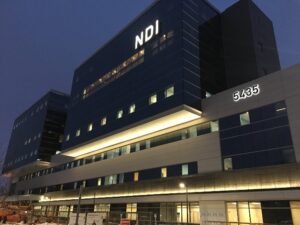I’ve had the opportunity to work on the Neuro Diagnostic Institute (NDI) project, which involves the construction of a new hospital, the NDI, in Indianapolis, which will replace the current State-operated facility, Larue Carter. Due to some fundamental changes in building layout and logistics, job functions and processes used today will look very different at the new facility.
One of the differences that will impact hospital processes is the transition to a new record keeping system. Under the old system they used a manual paper process for their records but in their new space, they will be utilizing an electronic medical record system.
Additionally, the building design itself is entirely different, which impacts just about everything including:
- Paths of travel
- How staff interact with patients
- How patient meals are prepared and delivered
- Where specific treatments and activities occur.
In simple terms, more things are changing than staying the same.
As you can probably imagine, it has been critical to find ways to strategically utilize the new space to optimize patient care. Business Process Mapping (BPR) has been instrumental in these planning efforts.
Before a future process can really be optimized, it’s crucial to have a keen understanding of how things are done today. It is also important to decide if the value of a process is worth bringing to a new space.
 The first BPR activity we engaged in was deciding which processes were important and necessary to the NDI and then mapping out how a process currently worked. During this activity, it was interesting to listen to different people’s perception of how a process looked. The communication and discussion that occurred in these meetings brought value and clarity to existing processes amongst co-workers.
The first BPR activity we engaged in was deciding which processes were important and necessary to the NDI and then mapping out how a process currently worked. During this activity, it was interesting to listen to different people’s perception of how a process looked. The communication and discussion that occurred in these meetings brought value and clarity to existing processes amongst co-workers.
The next step took their current processes and began to fit them into the new facility design. In some cases, there wasn’t a lot of change needed for a process, but many processes would end up looking drastically different. A good example of this involved their main source of communication. In today’s environment they utilize phones and overhead paging, but at the new hospital, they will utilize a hands-free, wireless communication device, called Vocera. Since the main communication method is changing there is a significant impact on a lot of processes.
BPR has ultimately been a key tool for the planning and understanding of how to function in the new hospital. Many of the processes have been clearly defined, mapped out, and are being used as training tools to instruct staff members how to function at the new facility.

Andrew is a Senior Consultant with over ten years of experience in a variety of fields related to Medicaid IT systems, hospital Construction and technical integration, public health, telecommunications, and residential construction. He’s currently a Project Manager for The My Healthy Baby Program which is a state operated program that connects pregnant Hoosiers to local services all across Indiana.
Andrew holds a PMP Certification and is a certified Scrummaster.



